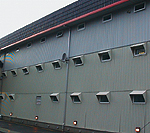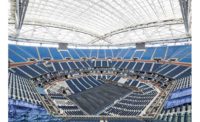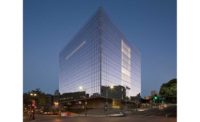Because of their climate or geology different countries have developed their own special skills for engineering building resistance to survive extreme local conditions. Northern Ireland faces few such natural challenges, but its hard history of political violence provided design expertise that may now be in demand as other countries confront their buildings' vulnerability to terrorism.
In decades of strife, Northern Ireland engineers have progressively learned how to design buildings to fend off all sorts of attacksfrom lone rifle shots to earth-trembling car bombs. "In the early days, the threat was unknown and was evolving rapidly," says a senior official at the Police Service of Northern Ireland (PSNI), requesting anonymity. "Now the design is still done on a threat basis, but we now can predict the threat."
Full-sale explosive testing and forensic engineering have generated a library of design knowledge potentially useful outside the province, believes George Mitchell, managing director of the design firm TeraProof Ltd., Banbridge, Northern Ireland. That's because, while anthrax and aircraft strikes are the most horrific threats to the U.S., 80% of likely terrorist attacks will be by homemade bombs left in parked vehicles, he believes. "It's cheap and it's easy."
 |
| STRONG WALLS Reinforced exterior counters more forceful methods of attack. (Photos courtesy of Teraproof) |
PAINFUL RESEMBLANCE
Across the Atlantic Ocean, a car bomb attack that killed 35 people inside a nightclub outside of Bogota must have seemed chillingly familiar to veterans of the long fight against terrorism in Northern Ireland. While conceding that hard evidence is lacking, Colombian Vice President Francisco Santos said that the attack strongly suggested a link between the Irish Republican Army and the Revolutionary Armed Forces of Colombia (FARC). The nightclub attack, in which six children died, came during the first day of a trial in a Colombian court of three alleged IRA members who face charges of training FARC guerrillas.
In the uneasy Northern Ireland peace following the 1998 "Good Friday Agreement," building design has softened, says the PSNI official. "Concrete cube" police stations are no longer acceptable, and have begun being demolished. New stations in PSNI's $100-million construction program will resemble ordinary buildings but will allow for hardening later if necessary. "You can put another skin on the outside, so you need to have foundations wide enough, and you have to be able to upgrade the roof," he adds.
For firms specializing in hardened buildings, the peace dividend has been negative. "There's been no market...in the province since 1998. Because of the paramilitary cease-fire, the British government took the attitude that they were going to build for peace," says Mitchell.
With security work drying up at home, specialist firms looked overseas. "We looked at Colombia and quite a few places," says Jim Henry, chairman of the Henry Group N.I. Ltd., a small Belfast contractor. In the 1990s, Henry worked exclusively for the police and defense department, he says. But he was deterred from exporting by his lack of local knowledge. In setting up foreign joint ventures, "you've got to be very careful," he says.
 |
| CAMERA Street-level surveillance is a simple but effective means of deterrence for existing structures. (Photos courtesy of Teraproof) |
TeraProof has been luckier, landing work in Colombia and positioning itself to bid in the U.S. Watching TV news out of the U.S. after Sept. 11, 2001, Mitchell saw opportunities. On his TV screen were images of workers placing "3-ft manhole rings" as security barriers around the White House. "I thought [that] these people didn't know what they were doing," he remembers.
Mitchell's U.S. introduction was eased by Richard Allen, a partner of Boston-based law firm Gadsby Hannah LLP. "Since we deal with risk and liability in building construction, the security aspects since Sept. 11 have become a big thing," says Allen, who could find little engineering expertise at home. "Design standards in the U.S. have never contemplated security issues....We haven't seen that much activity on the ground, outside of airports," he says.
Seeing a need for specialist engineering, Allen took the time while visiting Northern Ireland on business to meet Mitchell. He put Mitchell in touch with a large, undisclosed U.S. design firm. They will bid jointly before this Easter for a security assessment contract in Massachusetts, covering some 5,000 buildings. "There are [also other] consulting contracts in the U.S., let both by state and federal bodies, to report on their facilities. It's an assessment, basically," says Mitchell.
For existing buildings, Mitchell recommends making windows shatter-proof by applying a stick-on film. In London, net curtains, universally used in government building, have proved effective in containing flying glass. In large U.S. cities, creating safe internal building areas "is one structural enhancement that can be quite easily done." Because evacuating threatened offices in densely populated areas is dangerous, "the safest thing to do is put [people] in the center of a building," he adds.
Starting as a normal design firm, TeraProof's security expertise grew from the escalation of paramilitary activity in the province from the mid-1980s, remembers Mitchell. After the IRA killed nine police officers in a mortar attack in Newry in 1985, "the government began to take their responsibilities more seriously in terms of providing security for police stations," he says.
 |
| MODULAR Precast concrete panel assembly sped construction pace, and minimized risk to work force. (Photos courtesy of Teraproof) |
At the peak of the troubles, the firm employed five times more staff than the dozen or so it now has. Its work for the government centered on "special projects...not typical office buildings," says an official at the Northern Ireland Dept. of Finance and Personnel (DFP), which is responsible for government accommodation and construction. "The hardening went beyond the normal range of enhancements," he adds.
Terrorist attacks in the province have been direct and lethal, with heavy mortars, machine guns, rockets and oil drums filled with explosives. More remotely, the IRA used car bombs and driverless excavators carrying explosives to targets. And most insidiously, they have forced ordinary delivery drivers to carry "proxy bombs" by taking their relatives hostage.
"Excluding police stations, the terrorist threat has been a general one with commercial buildings probably sustaining more damage than those in the government estate," says the DFP official. "Terrorist campaigns in other countries appear to follow a similar pattern."
In response to the growing attacks, Northern Ireland authorities, followed by England, began adding blast resistance to public buildings some 20 years ago. Enhancements, typically involving reinforced structural frames and laminated glass in windows, now add about 3% to the cost of new building, estimates the DFP official. "Much higher costs would be incurred if the building were also designed to combat a specific threat."
As defensive engineering improved, the IRA focused increasingly on intimidating construction teams on security building projects, says Mitchell. "There were a large number of construction...workers killed over the next 10 years," he adds. Jim Henry recalls five deaths arising from well over 100 threats to his work force in the 1980s.
Mitchell himself received death threats and continues to take extra care with his safety. The engineering response to intimidation was to minimize time spent on sites and reduce the supply chain by maximizing prefabrication. Because of local cement supply difficulties, Mitchell even helped set up a private import company, he says.
 |
| LESSONS LEARNED Colombian police station design features double-skinned walls to allow defenders to move under cover. (Photos courtesy of Teraproof) |
Reducing the use of cast-in-place reinforced concrete in favor of prefabrication is one lesson Mitchell hopes to transfer to Colombia. With assistance from the British government, the firm has been appointed to advise Colombian authorities on countering IRA tactics, he says. "There has been a traffic of technology from the Provisional IRA to FARC," he says. Until recently, weapons were 1980s-Belfast vintage, but more recent attacks suggest FARC is now up to date, he adds.
Working with a local architect, TeraProof is developing preliminary designs for approximately 200 hardened police posts around Colombia. Designed for sustained attack, they include double-skin outer walls with space enough for defenders to move about under cover. Another defense will be a still secret design for rapidly deployable perimeter walls.
The police stations cost about $750,000 each to build. The schedule allots five years for construction, but work is now on hold because of events elsewhere. The project sponsor, the U.S. Army Corps of Engineers, has redirected its attention to Iraq, says Mitchell.
Click below to view more articles from this special report >>
BUILDING FOR A SECURE FUTURE
OVERVIEW
INFRASTRUCTURE
COMPANY PROFILE
PORT PROTECTION
INFORMATION TECHNOLOGY
RISK ASSESSMENT
SECURITY PRODUCTS



